Hi,
I am building a speaker based on a Eminnence Beta8cx. I soon learn the challenges of getting low bass from an 8" driver, big box needed... Either that or a ridiculously long port.
I am now looking at passive radiator. Seems to have quite a lot of advantages, as well as disadvantages.
Dayton Audio SD215-PR 8" Passive Radiator
Looking at some calculators such as this one.
mh-audio.nl - Home
I realized that the resonant frequency depends on box volume and radiator Mms. The bigger the box volume the smaller the Mms required. Of course I think there must be a trade off in this. It is well known that Mms also affects the efficiency of speaker drivers, the lower the Mms the higher the higher the efficiency. Would this be true for passive radiators as well, where a bigger box and a lighter PR will have a higher bass boost for the same fs?
I also notice that the parameters for calculation also excludes radiator compliance (cms). I suppose they might have regarded it as being small compared to the compliance offered by the box. But I am not sure.
Any advice on anyone who have had experience fooling around with a passive radiator is appreciated...
Oon
I am building a speaker based on a Eminnence Beta8cx. I soon learn the challenges of getting low bass from an 8" driver, big box needed... Either that or a ridiculously long port.
I am now looking at passive radiator. Seems to have quite a lot of advantages, as well as disadvantages.
Dayton Audio SD215-PR 8" Passive Radiator
Looking at some calculators such as this one.
mh-audio.nl - Home
I realized that the resonant frequency depends on box volume and radiator Mms. The bigger the box volume the smaller the Mms required. Of course I think there must be a trade off in this. It is well known that Mms also affects the efficiency of speaker drivers, the lower the Mms the higher the higher the efficiency. Would this be true for passive radiators as well, where a bigger box and a lighter PR will have a higher bass boost for the same fs?
I also notice that the parameters for calculation also excludes radiator compliance (cms). I suppose they might have regarded it as being small compared to the compliance offered by the box. But I am not sure.
Any advice on anyone who have had experience fooling around with a passive radiator is appreciated...
Oon
Couple things right off:
!) Try Jeff Bagby's software, much more user friendly and if you have excel. Just choose PR on the left hand size right below the TS (speaker parameters) input section. Just enter the PR specs and you can get very close.
Loudspeaker Design Software
2) that coaxial you have chosen is never going to get "low" mid-60's, but more like high 70's and only 3mm of excursion. A larger box to get more bass, will only result in the speaker getting destroyed from going past it's excursion limits very easily.
That is more of a PA speaker, usually designed for 80-100 and up to play very loud, because you have 2-4 15" bass bins for all the lows. No exactly a speaker for loud personal use without supplementing with 1-2 subs.
!) Try Jeff Bagby's software, much more user friendly and if you have excel. Just choose PR on the left hand size right below the TS (speaker parameters) input section. Just enter the PR specs and you can get very close.
Loudspeaker Design Software
2) that coaxial you have chosen is never going to get "low" mid-60's, but more like high 70's and only 3mm of excursion. A larger box to get more bass, will only result in the speaker getting destroyed from going past it's excursion limits very easily.
That is more of a PA speaker, usually designed for 80-100 and up to play very loud, because you have 2-4 15" bass bins for all the lows. No exactly a speaker for loud personal use without supplementing with 1-2 subs.
Thanks Bullithang, it really helps me understand things a lot better using the software. The performance of the Dayton is not as great as using the SEAS 8 inch equivalent. The difference in the amount of boost is almost 10 db.
From what I could tell, the most probable cause is the Qms. The SEAS is a lot higher, meaning there is a lot less losses in this system and hence create a much better increment in bass. Should have done this before I ordered the passive radiator.
Is there a difference qualitative wise between using a low Q versus a high Q passive radiator.
Thanks.
Oon
From what I could tell, the most probable cause is the Qms. The SEAS is a lot higher, meaning there is a lot less losses in this system and hence create a much better increment in bass. Should have done this before I ordered the passive radiator.
Is there a difference qualitative wise between using a low Q versus a high Q passive radiator.
Thanks.
Oon
No, the mass of the PR and the air of the box form a mass-spring system of which only the resonance frequency and damping are parameters. (Ignoring the suspension compliance of the PR) Of course things change as you change the box volume, but it doesn't matter whether you have a big, heavy PR or a smaller and lighter one. Run some simulations with WinISD for example to try.I realized that the resonant frequency depends on box volume and radiator Mms. The bigger the box volume the smaller the Mms required. Of course I think there must be a trade off in this. It is well known that Mms also affects the efficiency of speaker drivers, the lower the Mms the higher the higher the efficiency. Would this be true for passive radiators as well, where a bigger box and a lighter PR will have a higher bass boost for the same fs?
Correct. The PR suspension compliance adds a notch in the frequency response at the free air resonance frequency of the PR, which usually is below the lower cutoff of the system.I also notice that the parameters for calculation also excludes radiator compliance (cms). I suppose they might have regarded it as being small compared to the compliance offered by the box. But I am not sure.
A better parameter to compare is the Rms as the Qms of a passive radiator depends on fs and therefore on the amount of mass the manufacturer included. High Rms (low Qms) means higher losses / damping and therefore 1-2 dB less output around the tuning frequency.Is there a difference qualitative wise between using a low Q versus a high Q passive radiator.
The Dayton SD215-PR is quite lossy. No real problem though, just crank up the bass a bit.
Last edited:
Looking into what I was trying to sim, I have some questions. I notice that the SEAS 22cm passive radiator has a Qmp of 9 in the excel sheet. owever in the datasheet. That data is actually not provided. How did they arrive at this value I wonderThis seems quite reasonable compared to other Q values for other passive radiators. However the Qmp for the Dayton is only 2. That seems rather low, I wonder if the had estimated it wrongly? However in the datasheet. That data is actually not provided. How did they arrive at this value I wonder.
Oon
Oon
A better value to compare is the Rms as the Qms of a passive radiator depends on fs and therefore on the amount of mass the manufacturer included. High Rms (low Qms) means higher losses / damping and therefore 1-2 dB less output around the tuning frequency.
Hi TBTL,
Sounds like you know a thing or two about this topic. The Qmp of the Dayton is given as 2. Is this a reasonable number ? Or do you think there is somethign wrong with it. Other passive radiators tend to give values closer to 10.
How do I get the Rms value. Say for instance from the dayton?
Thanks.
Oon
There are formulas to calculate some Thiele / Small parameters from others. WinISD will also do it: if you enter some parameters, it will calculate the others for which it has enough information.
I do not know whether the data on the Dayton is correct. If it is, it is quite lossy.
I do not know whether the data on the Dayton is correct. If it is, it is quite lossy.
Yes, I also wonder how Dayton came to a Qmp parameter. We know that with drivers we need the voice coil Rdc value to compute the Qms. Seas doesn't give any Qm values for SP22R. I would stick to simulating the right size and mass of PR in order to get the optimal summing.
You might be confused with Qes.We know that with drivers we need the voice coil Rdc value to compute the Qms.
Qms = 2*pi*fs*mms/rms
https://en.wikipedia.org/wiki/Thiele/Small
Yeah, R is mechanical resistance.
BTW I would just slap an ex-speaker cone ( membrane+basket &suspensions ) but without the magnet, onto the box, and about a size bigger as it is in the norm.
😱
BTW I would just slap an ex-speaker cone ( membrane+basket &suspensions ) but without the magnet, onto the box, and about a size bigger as it is in the norm.
😱
Maybe I am or maybe I am trying to find out a reasonable explanation.
Yiur wiki link states following:
"Rms =Units are not usually given for this parameter, but it is in mechanical 'ohms'. Rms is a measurement of the losses, or damping, in a driver's suspension and moving system. It is the main factor in determining Qms. Rms is influenced by suspension topology, materials, and by the voice coil former (bobbin) material."
Where the voice coil in a PR is, beats me.
BeatsWhere the voice coil in a PR is, beats me.
...is the word...
...is the word...
...is the word.....
( just check the Beats' passive "suspended coins" on the back)
Hi,
In my opinion the Dayton DS215PR and the Eminence Beta 8cx are not a good match for a passive radiator system. You cannot design a flat response with it. The moving mass Mmp of the Dayton seems to be 75g minimum. The Dayton is more intended to use together with speaker drivers with a low fs.
The Beta 8cx has a rather stiff suspension, its fs is 62Hz and Vas is 21.4 litres. Like mentioned earlier, you cannot make a system that goes low with the Beta 8cx.
For a passive radiator system with this driver you have to choose a enclosure volume of about 12 litres and choose a good matching passive radiator to give some boost in the 70-150Hz frequency region. The Seas SP22R is a good choice. I have done some simulations based on the R.Small passive radiator transfer functions with a self made calculation tool with Pspice and also with the Unibox407 calculation tool. Both calculations give the same results. You can realize a flat response with a -3dB point at about 80Hz. For the SP22R I have chosen Mmp=28g, Sdp=230cm2, Vap=138 litres. The resonance frequency fB is about 75Hz for this system. Unibox tells me that the passive radiator maximum excursion appears at 60W. I will check that in a Leap simulation soon. It will take me some time, because I have to make transducer models in Leap for that simulation.
When you can give me an idea of the enclosure sizes you have in mind, I can do the Leap simulation inclusive the enclosure response also.
Paul
In my opinion the Dayton DS215PR and the Eminence Beta 8cx are not a good match for a passive radiator system. You cannot design a flat response with it. The moving mass Mmp of the Dayton seems to be 75g minimum. The Dayton is more intended to use together with speaker drivers with a low fs.
The Beta 8cx has a rather stiff suspension, its fs is 62Hz and Vas is 21.4 litres. Like mentioned earlier, you cannot make a system that goes low with the Beta 8cx.
For a passive radiator system with this driver you have to choose a enclosure volume of about 12 litres and choose a good matching passive radiator to give some boost in the 70-150Hz frequency region. The Seas SP22R is a good choice. I have done some simulations based on the R.Small passive radiator transfer functions with a self made calculation tool with Pspice and also with the Unibox407 calculation tool. Both calculations give the same results. You can realize a flat response with a -3dB point at about 80Hz. For the SP22R I have chosen Mmp=28g, Sdp=230cm2, Vap=138 litres. The resonance frequency fB is about 75Hz for this system. Unibox tells me that the passive radiator maximum excursion appears at 60W. I will check that in a Leap simulation soon. It will take me some time, because I have to make transducer models in Leap for that simulation.
When you can give me an idea of the enclosure sizes you have in mind, I can do the Leap simulation inclusive the enclosure response also.
Paul
Last edited:
Hi,
In my opinion the Dayton DS215PR and the Eminence Beta 8cx are not a good match for a passive radiator system. You cannot design a flat response with it. The moving mass Mmp of the Dayton seems to be 75g minimum. The Dayton is more intended to use together with speaker drivers with a low fs.
The Beta 8cx has a rather stiff suspension, its fs is 62Hz and Vas is 21.4 litres. Like mentioned earlier, you cannot make a system that goes low with the Beta 8cx.
For a passive radiator system with this driver you have to choose a enclosure volume of about 12 litres and choose a good matching passive radiator to give some boost in the 70-150Hz frequency region. The Seas SP22R is a good choice. I have done some simulations based on the R.Small passive radiator transfer functions with a self made calculation tool with Pspice and also with the Unibox407 calculation tool. Both calculations give the same results. You can realize a flat response with a -3dB point at about 80Hz. For the SP22R I have chosen Mmp=28g, Sdp=230cm2, Vap=138 litres. The resonance frequency fB is about 75Hz for this system. See Unibox simulation result in attached image. Unibox tells me that the passive radiator maximum excursion appears at 60W. I will check that in a Leap simulation soon. It will take me some time, because I have to make transducer models in Leap for that simulation.
When you can give me an idea of the enclosure sizes you have in mind, I can do the Leap simulation inclusive the enclosure response also.
Paul
In my opinion the Dayton DS215PR and the Eminence Beta 8cx are not a good match for a passive radiator system. You cannot design a flat response with it. The moving mass Mmp of the Dayton seems to be 75g minimum. The Dayton is more intended to use together with speaker drivers with a low fs.
The Beta 8cx has a rather stiff suspension, its fs is 62Hz and Vas is 21.4 litres. Like mentioned earlier, you cannot make a system that goes low with the Beta 8cx.
For a passive radiator system with this driver you have to choose a enclosure volume of about 12 litres and choose a good matching passive radiator to give some boost in the 70-150Hz frequency region. The Seas SP22R is a good choice. I have done some simulations based on the R.Small passive radiator transfer functions with a self made calculation tool with Pspice and also with the Unibox407 calculation tool. Both calculations give the same results. You can realize a flat response with a -3dB point at about 80Hz. For the SP22R I have chosen Mmp=28g, Sdp=230cm2, Vap=138 litres. The resonance frequency fB is about 75Hz for this system. See Unibox simulation result in attached image. Unibox tells me that the passive radiator maximum excursion appears at 60W. I will check that in a Leap simulation soon. It will take me some time, because I have to make transducer models in Leap for that simulation.
When you can give me an idea of the enclosure sizes you have in mind, I can do the Leap simulation inclusive the enclosure response also.
Paul
An externally hosted image should be here but it was not working when we last tested it.
As an illustration I have simulated in Leap the Eminence Beta 8CX and the Seas SP22R mounted in a 12.5 litre box.
The SPL at 1m 2.83Vrms on infinite baffle, drivers mounted in a 12.5 litre box:
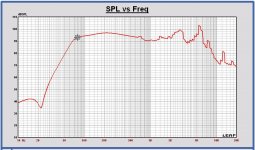
The infinite baffle response gives a good idea of the low frequency system behaviour (because the enclosure repsonse is not included yet).
The SPL at 1m 2.83Vrms in free space, drivers mounted in a 12.5 litre box:
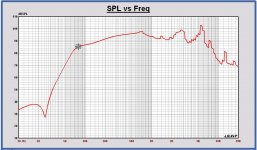
Now the enclosure response is added in the total response.
The impedance at 2.83Vrms, drivers mounted in a 12.5litre box:
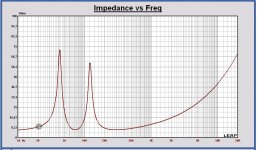
The excursion at 2.83Vrms, the active driver in brown color and the passive radiator in green color.
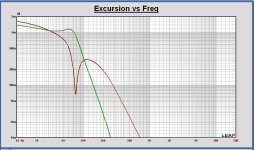
The values in the excursion graph are rms values and have to be multiplied by 1.4 to obtain the peak values. The excursion of the passive radiator is 1.6mm peak at 63Hz for 2.83Vrms applied. The maximum excursion for this passive radiator is 10mm peak and appears for 17Vrms at 63Hz in this system. This corresponds with a SPL=104dB at 1m distance.
Simulation environment and chosen enclosure shape in Leap.
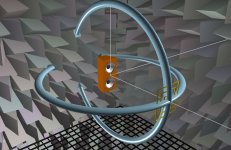
The SPL at 1m 2.83Vrms on infinite baffle, drivers mounted in a 12.5 litre box:

The infinite baffle response gives a good idea of the low frequency system behaviour (because the enclosure repsonse is not included yet).
The SPL at 1m 2.83Vrms in free space, drivers mounted in a 12.5 litre box:

Now the enclosure response is added in the total response.
The impedance at 2.83Vrms, drivers mounted in a 12.5litre box:

The excursion at 2.83Vrms, the active driver in brown color and the passive radiator in green color.

The values in the excursion graph are rms values and have to be multiplied by 1.4 to obtain the peak values. The excursion of the passive radiator is 1.6mm peak at 63Hz for 2.83Vrms applied. The maximum excursion for this passive radiator is 10mm peak and appears for 17Vrms at 63Hz in this system. This corresponds with a SPL=104dB at 1m distance.
Simulation environment and chosen enclosure shape in Leap.

I missing a point why Eminence beta 8 cx has to be in a big box bearing in mind that it models nicely in an appropriately sized ported cabinet, given its Qts=0,296. Fb=60 Hz; Vb= 15 litres; port 2,5" by 5".
Where the voice coil in a PR is, beats me.
Voice coil bobbin/former material only affects Qms if there is a magnet (eddy currents in a conductive former lower Qms).
There is a voice coil bobbin on many PR's, but there is no voice coil or magnet 😉
Trouble is, Rmp changes with frequency, sometimes a lot.
When you add mass to a PR, Fp goes down and Rmp may also go down.
The Dayton PR's are just woofers with no magnet or voice coil, retaining the bobbin and spider, AFAIK. THey have a relatively high resonance and limited excursion and are sometimes not suitable for high performance or low resonance PR uses.
I agree, a basreflex system also can be a good choice. The enclosure volume can be about the same.I missing a point why Eminence beta 8 cx has to be in a big box bearing in mind that it models nicely in an appropriately sized ported cabinet, given its Qts=0,296. Fb=60 Hz; Vb= 15 litres; port 2,5" by 5".
Paul
Hey, I actually tried that in the software... Unfortunately the answer is not good.. The resonant frequency is quite high and very little boost. The Mms and qms is too low....Yeah, R is mechanical resistance.
BTW I would just slap an ex-speaker cone ( membrane+basket &suspensions ) but without the magnet, onto the box, and about a size bigger as it is in the norm.
😱
Sent from my F8332 using Tapatalk
The Fs gets pushed upwards. But I guess it happens to all speakers. One of the speakers I heard that I really like is the Audio Note... I realize after messing around with an 8 inch why their box is so big, to prevent pushing up the Fs..I missing a point why Eminence beta 8 cx has to be in a big box bearing in mind that it models nicely in an appropriately sized ported cabinet, given its Qts=0,296. Fb=60 Hz; Vb= 15 litres; port 2,5" by 5".
- Status
- Not open for further replies.
- Home
- Loudspeakers
- Multi-Way
- Passive radiator Questions